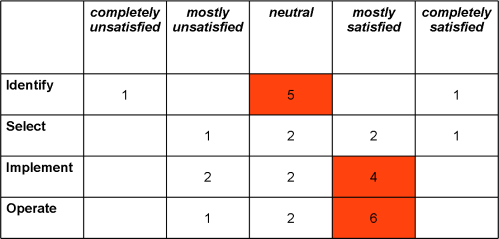So now we come to the final phase. This is the stage with the most detailed responses to this question (N=7), and with a number of regrets! People, support and features are the keywords here.
Again, we have seen the need for better training emerge, along with a recognition of the need to “spend more time on templates and end-user guidance” and to “focus on [the] user base rather than technology”.
From the other side of the coin, there was a recognition of the need to get more support from key management in the earlier stages of the program. One respondent reported that a decision was made by one department in the organisation to ignore the product choice of another department, and select a different, unproven (and inappropriate) product. This respondent did not have the power to influence the decision. If both departments had agreed on a selection, the organisation could have saved “several million dollars”.
So far as support in the technological sense was concerned, one respondent stated the need for a new system to be installed in a stable environment, and another reported that a lack of funding had led to low priority hosting support for the project, resulting in poor service levels and prolonged outages (caused by issues unrelated to the chosen collaborative software). Funding for self-hosting is the desired solution to this.
A couple of respondents saw a need for better choice of features in the systems selected – the full suite of software should have been purchased, not a limited sub-set. For instance, web-cam conferencing should have been included in one case, and blogging and RSS should have been implemented along with the content management software in another.
Finally, a recognition of the need to “place more emphasis on advertising the benefits” was reported.
So our take-outs from this final stage can once more repeat:
- The introduction of collaborative systems takes time, and needs a strong focus on the needs of people.
To which we can add:
- The introduction of collaborative systems needs senior-level support, and recognition of the benefits of appropriate investment.
- Be very clear on the needs of the people who will use the system, and ensure that the appropriate functionality is provided to meet these needs.
And on that note, we draw to a close our analysis of the Australian Collaboration Software Report! Thanks again to all our respondents.
So what happens now? Watch this space…



